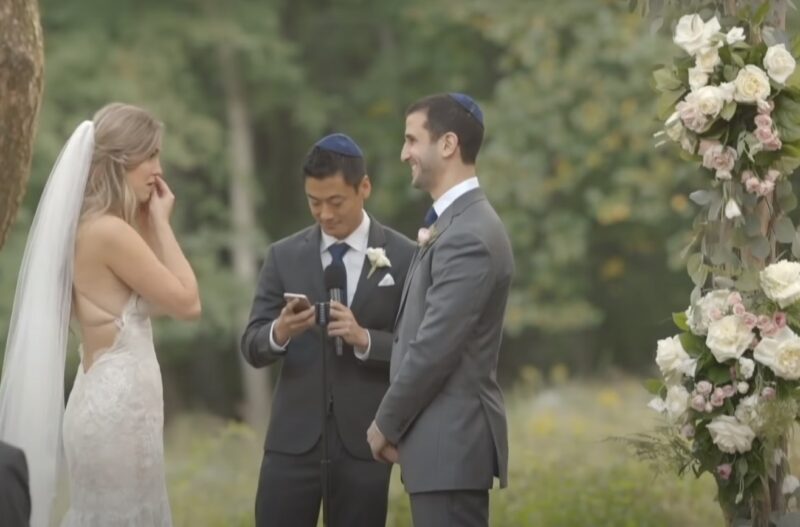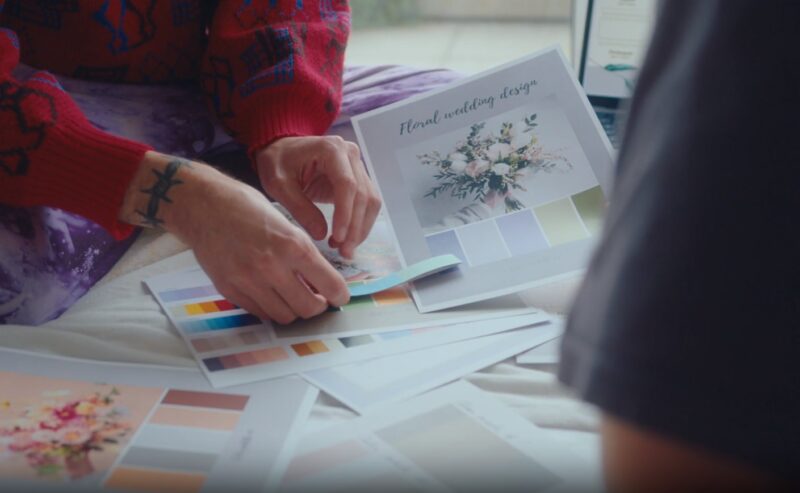Planning an interfaith wedding presents unique challenges and opportunities. It’s a journey that combines different beliefs, traditions, and customs into a single, unified celebration.
This blog post is dedicated to guiding you through the intricate process of planning an interfaith wedding that honors both partners’ faiths and creates a harmonious, memorable event.
The Importance of Respecting Both Faiths

An interfaith wedding is about merging two people and blending two distinct faith backgrounds.
The key to a successful interfaith wedding lies in the respect and acknowledgment of both religions or beliefs.
This mutual respect ensures that neither partner feels their faith is being overshadowed or neglected.
Embracing each other’s beliefs can foster a deeper understanding and appreciation within the relationship.
Bridging Cultural Differences
Interfaith weddings often involve not just a mix of religions but also a blend of cultures. Knowing and celebrating these cultural differences can make your wedding richer and more meaningful.
It’s an opportunity to showcase the beauty and traditions of both backgrounds, creating a vibrant tapestry of customs and practices.
Creating a Unique and Personal Ceremony
One of the most exciting aspects of an interfaith wedding is the opportunity to create a ceremony that is uniquely yours.
This type of wedding breaks free from the constraints of a single-faith ceremony, allowing you to craft a personalized experience that truly represents both partners.
It’s a chance to innovate, to be creative, and to set a tone that reflects the couple’s shared values and beliefs.
Family Expectations and Traditions

Open and honest communication with both families is crucial in planning an interfaith wedding.
It’s important to discuss the significance of certain traditions and practices in each faith and to understand family expectations.
These conversations can sometimes be challenging but are essential in creating a wedding that respects both families’ beliefs.
Balancing Traditions
Striking a balance between different traditions can be one of the trickiest parts of planning an interfaith wedding. The goal is to represent both faiths equally, without one overshadowing the other.
It might involve blending ceremonies, alternating rituals from each faith, or even creating new traditions that honor both backgrounds.
Handling Sensitive Issues
Certain religious or cultural practices might be sensitive or controversial when blended. It’s important to approach these issues with sensitivity and understanding.
Seek advice from religious leaders or cultural experts to navigate these complexities. Sometimes, compromises or adjustments are necessary to ensure that both faiths are honored respectfully.
Selecting the Right Officiants

The choice of officiants is crucial in an interfaith wedding. Ideally, you should look for individuals who are open-minded and respectful of both faiths.
In some cases, couples opt for two officiants, each representing one faith, to conduct the ceremony jointly.
The Role of Officiants in an Interfaith Ceremony
Officiants play a pivotal role in interfaith weddings. They not only lead the ceremony but also help the couple navigate the blending of traditions and rituals.
The right officiants can bridge the gap between the faiths, offering insights and suggestions to create a harmonious ceremony.
Working with Officiants to Create a Unified Ceremony
Collaborating closely with your officiants is key to crafting a ceremony that feels seamless and unified. Discuss your vision, the elements you wish to include from each faith, and how they can be integrated effectively.
The officiants can offer valuable guidance on how to blend different rituals in a way that is respectful and meaningful.
Designing a Ceremony That Honors Both Faiths

Incorporating elements from both faiths requires careful planning and consideration. It’s about finding rituals, readings, music, or symbols that resonate with both religions or cultures.
This could mean adapting traditional rituals to suit an interfaith setting or selecting readings that echo shared values.
Creating a Cohesive Flow
The flow of the ceremony is important in an interfaith wedding. It should smoothly transition from one tradition to another, maintaining a rhythm that feels natural and cohesive.
This might involve alternating between rituals from each faith or blending them in a way that feels fluid and harmonious.
Personalizing the Ceremony
While honoring both faiths is paramount, the ceremony should also reflect the couple’s personality and relationship.
Personal touches, whether in vows, music, or decorations, can make the ceremony feel intimate and unique. It’s about striking a balance between tradition and personal expression.
Practical Considerations in Planning an Interfaith Wedding

Venue Selection
Choosing a venue for an interfaith wedding can be challenging. It should be a neutral space that doesn’t favor one faith over the other.
Some couples opt for non-religious venues, such as outdoor spaces or banquet halls, which can be decorated to reflect both faiths.
Food and Dietary Restrictions
Catering for an interfaith wedding may involve accommodating various dietary laws and preferences.
It’s important to be aware of any restrictions related to both faiths and to communicate these clearly to your caterer. Offering a diverse menu that respects these dietary needs is key.
Attire and Symbolic Items
Wedding attire and symbols like rings or ceremonial items should also reflect the interfaith nature of the event.
Couples might choose to wear traditional attire from both cultures or opt for a more neutral style. Similarly, symbolic items used in the ceremony should represent both faiths equally.
Planning the Reception in an Interfaith Wedding

The reception is a perfect opportunity to showcase the rich tapestry of cultures and faiths. This can be done through food, music, dance, and decorations.
The key is to create an atmosphere that celebrates the diversity and unity of your union.
Entertainment That Respects Both Cultures
Choosing entertainment that resonates with both cultures can enhance the inclusivity of the event.
This might involve a mix of music styles, performances, or even games that reflect the couple’s diverse backgrounds. The goal is to ensure that all guests feel included and part of the celebration.
Speeches and Toasts
Speeches and toasts at an interfaith wedding can be powerful moments of unity. Encouraging speakers to acknowledge and celebrate the coming together of two faiths can set a tone of inclusivity and respect.
It’s an opportunity for family members and friends to express their support for the couple’s interfaith journey.
Handling Logistical Aspects with Sensitivity

Wedding invitations should reflect the interfaith nature of the event. Including symbols or wording that represents both faiths can set the right tone.
It’s also crucial to communicate any special aspects of the ceremony or reception that guests should be aware of, such as dress codes or ceremonial practices.
Seating Arrangements and Decorations
Seating arrangements and decorations at the wedding and reception should be considerate of both faiths.
This might involve having separate seating for religious reasons or decorating the venue in a way that is neutral and respectful to both traditions.
Photography and Videography
Capturing an interfaith wedding through photography and videography requires knowledge of important moments in both faiths.
Informing the photographers and videographers about key rituals and moments to capture ensures that the essence of the interfaith ceremony is beautifully preserved.
The Importance of Ongoing Learning and Growth

An interfaith marriage is an ongoing journey of learning and exploration. It involves continually educating oneself about the partner’s faith and finding ways to incorporate this knowledge into daily life.
This process can deepen the couple’s connection and enrich their relationship.
Seeking Guidance and Counseling
Couples may find it beneficial to seek guidance or counseling, especially from professionals or leaders who are experienced in interfaith matters.
This can provide tools and insights for navigating the complexities of an interfaith relationship and fostering a healthy, respectful partnership.
Building a Community of Support
Building a community of friends and family who respect and support your interfaith marriage is invaluable.
Engaging in interfaith groups or communities can also provide a sense of belonging and a network of individuals who understand the unique dynamics of your relationship.
FAQs
How can we handle different dietary restrictions at our interfaith wedding?
Collaborate with your caterer to create a menu that includes diverse options catering to both faiths’ dietary laws.
Consider labeling dishes clearly and offering a mix of vegetarian, vegan, kosher, or halal options, ensuring all guests find something suitable.
Can we have a religious ceremony in a neutral venue?
Absolutely. Many couples choose neutral venues like banquet halls, gardens, or beaches for their interfaith ceremonies.
These venues can be adorned with elements from both faiths to create a sacred space that respects both traditions.
How do we manage differing religious views among guests at our wedding?
Communicate the interfaith nature of your wedding in invitations, and during the ceremony, have the officiant(s) briefly explain the significance of the blended rituals.
This fosters understanding and respect among guests of different faiths.
Are there specific counselors or resources for interfaith couples?
Yes, there are counselors who specialize in interfaith marriages, as well as online resources and community groups that provide support and advice for interfaith couples navigating their journey together.
How can we incorporate both faiths in our wedding vows?
You can write personalized vows that include elements or values from both faiths. Some couples choose to recite traditional vows from each faith or create a blend that reflects their shared beliefs and commitments.
Can we include traditional attire from both cultures in our wedding?
Certainly. Many couples choose to wear or incorporate elements of traditional attire from both cultures, either throughout the wedding or in different parts of the ceremony and reception, celebrating the richness of both backgrounds.
Final Words
Planning an interfaith wedding is a journey of love, respect, and understanding. It’s an opportunity to celebrate the richness of two distinct faiths and cultures, blending them into a unique and memorable event.
Embracing each other’s beliefs, communicating effectively, and carefully balancing traditions will let you create a wedding that truly represents your shared values and love.
